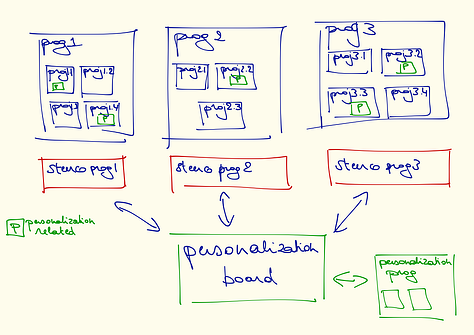Many companies are facing the challenge to identify and deliver more personalized services to their customers and are trying to evolve from an inside out perspective to an outside in approach. Making this switch takes time and reflection.
More on this topic at our AE Foyer on The Challenge of Personalization. Register here.
When assessing the ongoing project portfolio landscape in this context, many will notice that personalization related matters are scattered across the different programs, projects and change requests, making it very difficult to adopt a consistent strategy to make personalization happen in a structured way. Based on the experience from recent delivery tracks we can review a number of best practices for making this switch more successful.
The basic things
When implementing personalization, one of the first challenges is to recognize the user and knowing who is online. The process of recognizing someone in a physical interaction is much more simple than it is digitally.
Everyone knows the basics of logging in to a system.
The first two important steps that take place are:
- identification of the user, most of the time using a unique username;
- authentication of the user (making sure he or she is the one you know). Most systems use a password for this, which is based on “something you know”, i.e. a secret between you and the system.
When you extrapolate this concept across all of your systems, you will need a unique and federated ID (of relevance to personalization) and preferably put in place a mechanism for single sign on.
It is important to integrate a consistent identification/authentication mechanism in your various apps, applications, websites, third party solutions (also consider integrating with Facebook or Twitter authentication)
This will frequently lead to the need to apply change requests to several existing systems: a budget needs to be provided and the added value is not necessarily immediately clear for everyone.
Personalization challenges
The journey to personalization will also take you through questions like:
- what personalized information do you want to store?
- where (in which systems) do you want to store this information?
- how can you re-use this information?
- what about privacy, what is allowed and what isn't?
- how do you secure this personalized information?
- how do you set up a 360° view on the customer?
- what amount of personalized communication is required?
- is personalized communication consistent over different channels?
So far, so good. But we need to realize that we have been adopting an inside-out approach, considering most of the time the challenges of evolving with our existing application landscape in the right direction to prepare for structured personalization capabilities.
Let's also approach the previous topics from an outside-in perspective, knowing that we limit ourselves at this moment to specific and simple technical challenges.
Outside in
A customer visits a website or uses an application with a specific objective in mind: obtaining useful information, buying a product, ... The step of authentication is frequently required at a specific point in time in the process, but is, for sure, not the most interesting one. It certainly requires enough attention because it will influence the customer experience in the end-to-end process in a significant way. Ever refrained from purchasing a product because the online store's authentication process was too elaborate? Yes, me too.
So, following questions are important:
- what is my end2end user experience with a particular proces?
- what is my user experience of being identified/ authenticated?
- do I trust the organisation I am interacting with?
- am I able to decide what private information can be stored about me?
- can I revoke this authorization?
Building customer trust is a critical succes factor in the experience of personalization.
I suppose it's quite clear now that dealing with personalization in a structured way comes with many different questions and requires an appropriate organizational structure.
Switching from a reactive to a structured, proactive mode
The personalization-related topics, which are mentioned in the previous paragraphs, are typically dealt with as work packages of many different projects. Even more, they are scattered across different programs, projects and maintenance requests. Difficult questions are solved on a project by project basis and escalations are discussed by the project's or program's steering committee. Bear in mind that all related aspects of the problem are necessarily being considered, nor is involving all required parties for effective decision making.
Dealing with personalization as a crucial objective in your company's strategy will inevitably lead to the need to put in place a centralized governance structure for consistent decision-making.
Companies typically set up a personalization or customer management board for the definition of a personalization strategy and for consistent decision making in case of project escalations. Once the board is in place, projects under its direct governance can be kicked off to implement strategic components in the personalization journey.
Time to market
In a highly competitive world we are challenged to deliver new apps and websites at an aggressive pace serving specific primary customer interaction needs, not always allowing for the integration of personalization-compliant mechanisms. The tension between speed and architecture-driven product delivery requires attention. There's nothing wrong with this as long as we are aware that some refactoring is needed at a later stage to make it fully compatible to benefit from personalization capabilities.
Want to know more about effective personalization? Don't hesitate to register for our AE Foyer: The Challenge of Personalization on March 10, 2016





